Trees Birds Mammals Fish Amphibians Reptiles
Wild Algarve
Bookshop
Suillus luteus (L.) Roussel - Slippery Jack
Phylum: Basidiomycota - Class: Agaricomycetes - Order: Boletales - Family: Suillaceae
Distribution - Taxonomic History- Etymology - Identification - Culinary Notes - Reference Sources
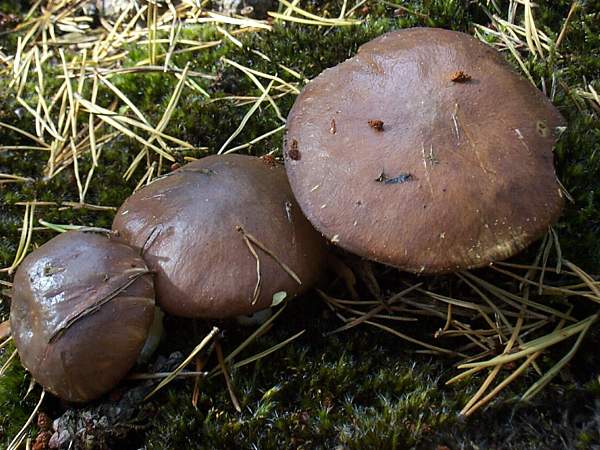
Suillus luteus, commonly known as Slippery Jack,
is a most widespread summer and autumn fungus. It is the type species of the Suillus genus. The very slimy (when wet) cap surface is the origin of the common name, which in some countries is applied to several members of the genus Suillus.
This edible bolete is
most often seen in large numbers beside paths in pine woods, and it is one of the boletes that has a distinctive ring, white at first but discolouring with age.
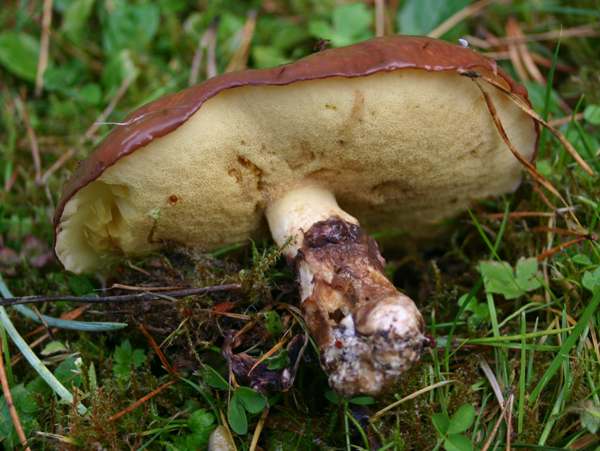
Distribution
Suillus luteus is common and widespread throughout Britain and Ireland, always in or beside pine plantations. This bolete copes well in cold northern climes, and is very common in Scandinavia; it occurs also throughout the rest of Europe, Asia and North America.
Taxonomic history
When in 1753 Carl Linnaeus described this bolete he called it Boletus luteus. Later, in 1888, Lucien Quélet moved it from the Boletus genus and named it Ixocomus luteus. The currently accepted scientific name of the Slippery Jack, Suillus luteus, dates from a 1796 publication by the French mycologist Henri François Anne de Roussel (1748 - 1812).
Synonyms of Suillus luteus include Boletus luteus L., and Ixocomus luteus (L.) Quél.
Suillus luteus is the type species of the Suillus genus.
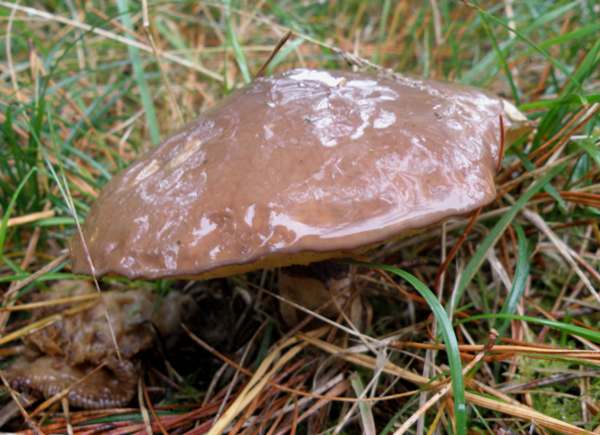
Etymology
The common name Slippery Jack (but please don't ask why Jack rather than Jill, Mary or Brian) is an obvious reference to the slimy nature of caps of this mushroom during wet weather - although they tend to become smooth and semi-matt and hence they are not particularly sticky during warm dry spells.
The specific epithet luteus seems obscure, because the Latin prefix lute- generally implies saffron yellow (the pores are yellow, but more lemon yellow than saffron); however, another meaning of luteus is dirty or muddy, and that may be the origin in this instance. If you have a reference source for this please let us know. Meanwhile the generic name Suillus is much more straightforward, coming from the Latin noun sus, meaning pig. Suillus therefore means 'of pigs' (swine) and is a reference to the greasy nature of the caps of all fungi in this genus.
Identification Guide
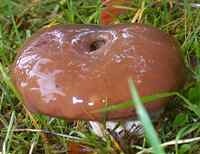 |
Cap
When wet, as shown on the left, the caps of this species are slimy;
in hot sunny weather they dry to a smooth semi-matt finish.
Usually dark chestnut brown, but occasionally quite a lot lighter, the caps
of Suillus luteus grow to between 5 and 10cm in diameter. |
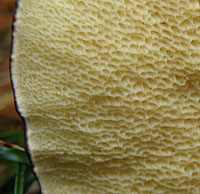
|
Tubes and pores
Beneath the cap, a white veil covers the lemon
yellow pores of this bolete. The veil tears to leave an irregular ring on
the stem and often pieces of veil hanging from the cap margin.
At first lemon yellow, the medium-sized round pores darken to a
sienna-yellow with age. |
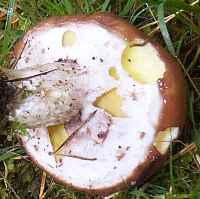 |
Stem
2 to 3cm in diameter and 5 to 10cm tall, the stem is pale straw-yellow at
first, darkening with a dot pattern above the ring and with an irregular
covering of brown longitudinal fibres near the base.
The large, floppy stem ring is white initially but usually develops a purplish tinge to its lower surface as the fruitbody matures. |
| |
Spores
Sub-fusiform, smooth, 8-10.5 x 3-3.5μm.
Spore print
Ochraceous or buff coloured. |
Odour/taste |
Not distinctive. |
Habitat & Ecological role |
Mycorrhizal; beneath conifers in damp, usually shaded
places. |
Season |
August to November in Britain and Ireland. |
Similar species |
Suillus grevillei has a bright yellow-orange cap and angular
pores; it occurs under larch. |
Culinary Notes
Although not generally rated very highly, Slippery Jacks are reported to be edible when thoroughly cooked. To reduce the risk of an adverse reaction to these kinds of mushrooms some people have found it beneficial to discard the cap skin of all species from the Suillus genus.
Reference Sources
Fascinated by Fungi, 2nd Edition, Pat O'Reilly 2016, reprinted by Coch-y-bonddu Books in 2022.
British Boletes, with keys to species, Geoffrey Kibby (self published) 3rd Edition 2012
Roy Watling & Hills, A.E. 2005. Boletes and their allies (revised and enlarged edition), – in: Henderson, D.M., Orton, P.D. & Watling, R. [eds]. British Fungus Flora. Agarics and boleti. Vol. 1. Royal Botanic Garden, Edinburgh.
BMS List of English Names for Fungi
Dictionary of the Fungi; Paul M. Kirk, Paul F. Cannon, David W. Minter and J. A. Stalpers; CABI, 2008
Taxonomic history and synonym information on these pages is drawn from many sources but in particular from the British Mycological Society's GB Checklist of Fungi.
Top of page...
Fascinated by Fungi. Back by popular demand, Pat O'Reilly's best-selling 450-page hardback book is available now. The latest second edition was republished with a sparkling new cover design in September 2022 by Coch-y-Bonddu Books. Full details and copies are available from the publisher's online bookshop...